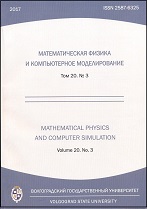|
Mathematics and mechanics
Estimating the module function which is analytic at rectilinear strip
I. V. Dzogij
I. G. Petrovsky Bryansk State University
Abstract:
The complex analysis of the role and values of analytic function’s estimates
is carried out within the range if a respective estimate is known at the boundary or part of
the boundary of this area. Such estimations play a significant role in the applications of the
theories of the functions of complex variables. It is enough to recall the Riesz – Thorin
theorem or the theorem of analytical capacity. In 1966 Yu.I. Maslyakov published the results
of estimations of the analytical function module inside the right half-plane, provided that
there was some estimate of decreasing the function module’ on the conjugate axis (see [4]).
It has been found that the estimates of this kind are fair not only for analytical continuous up
to the border and limited functions, but also for functions from the classes of I.I. Privalov
(see [5]), where at the border the estimate of ‘everywhere’ is replaced by “almost
everywhere” and the class of functions is significantly expanded, where the result is fair
(see [2; 7]). Similar estimates for the module of functions of I.I. Privalov can be obtained
not only in the right half-plane, but also in a single circle (see [1]), and in a straight lane
(see [6]).
Classification through $N_p(\Pi)$, the analytical class in a straight lane of functions $\displaystyle{\Pi=\left\{x+iy:|y|<\frac{\pi}{2}\right\}}$ satisfies the condition:
1) $\displaystyle{\sup_{-\frac{\pi}{2}<y<+\frac{\pi}{2}}\left\{\int_{-\infty}^{+\infty}\left(ln^{+}|f(x+iy)|\right)^{p}e^{-x}dx\right\}<\infty, p>0; }$
2) $\displaystyle{\lim_{x\rightarrow\infty}\frac{e^{-x}}{\pi} \int_{-\frac{\pi}{2}}^{+\frac{\pi}{2}}ln^{+}|f(x+iy)|dy=0, }$
where $\displaystyle{\ln^{+}a=\left\{
\begin{array}{c}
\ln a, \, \text{at} \, a>1; \\
0, \, \text{at} \, 0<a\leq 1 . \\
\end{array}
\right.
}$
This function class is called the class of I.I. Privalov in a straight lane.
Classification through “B” class of positive, increasing, continuous functions $\varphi(t)$ at $[0,+\infty)$ meets the conditions:
a) $\displaystyle{\varphi\left(e^t\right)}$ convex down at $t\geq0$;
b) $\displaystyle{\int_{0}^{\infty}\varphi\left(t\right)e^{-t}dt<+\infty}$;
c) $\displaystyle{\lim_{t\rightarrow+\infty}\frac{\varphi\left(e^t\right)}{t}=+\infty}$.
Theorem 1.
Let the function $f(z)\in N_{p}(\Pi),\, p>1$, and at the border of $\Pi$ aämost everywhere satisfy the condition
$$\left|f\left(x\pm i\frac{\pi}{2}\right)\right|\leq e{-\varphi(k)},\,(-\infty<x<+\infty). $$
where $\varphi(t)\in B$.
Then everywhere in $\Pi$ the following equation is valid
$$|f(z)|\leq Ke^{-\varphi(z)}, K=e^{\varphi(1)-\varphi(0)}. $$
Keywords:
module of analytic function, right half-plane, rectilinear strip, function class
of I.I. Privalov, Poisson’s kernel.
Citation:
I. V. Dzogij, “Estimating the module function which is analytic at rectilinear strip”, Mathematical Physics and Computer Simulation, 20:6 (2017), 16–25
Linking options:
https://www.mathnet.ru/eng/vvgum211 https://www.mathnet.ru/eng/vvgum/v20/i6/p16
|

|




 Contact us:
Contact us: Terms of Use
Terms of Use
 Registration to the website
Registration to the website Logotypes
Logotypes








 Citation in format
Citation in format 